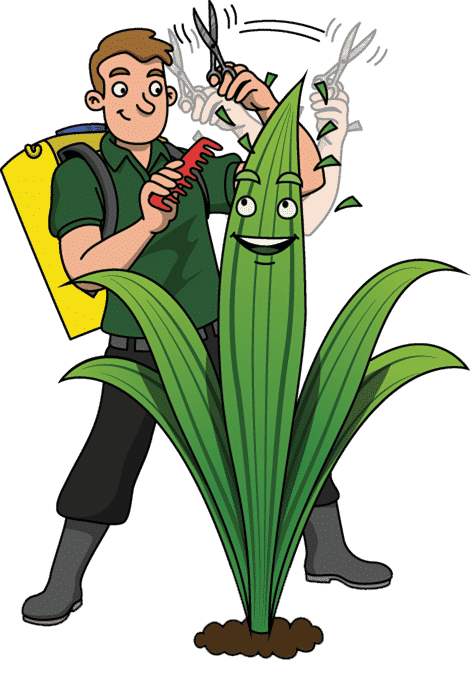

Lawn mowing is one of the most important tasks when it comes to lawn care. As lawn care experts, Green Man Lawn Care can do everything else, but mowing is the responsibility of our customers.
“Listening to our advice and employing the correct lawn mowing techniques will help you and your lawn gain more benefit from our treatments”
The key to a good lawn mowing regime is ‘little and often’. The more you cut a lawn, whilst taking the minimal amount of growth off from the top, the thicker the grass plants will grow, leading to a healthier looking sward of grass.
A thick lawn also makes it harder for moss and weeds to take hold.
The 5 key points to remember when cutting your lawn:
- Cut your lawn at the right height
- Mow your lawn at the correct frequency
- Keep your lawn mower blades sharp
- Don’t travel too quickly over the lawn
- Collect your grass clippings
Cut your lawn at the right height
The ideal height for grass plants in a lawn is between 1.5 inches and 2 inches. The plant should never grow beyond 3 inches and should always be cut back down to the same height, ensuring that no more than a third of the height of the plant is removed.
Why is this so important?
The grass plant differs from most other varieties of plants because it has evolved to grow new leaves from the bottom of the plant, rather than from the leaf stems. This is because grass is the primary feed for grazing animals such as cows and sheep. These animals, continually eat the grass plant leaves, leaving enough leaves on the plant for it to continue growing and producing new growth. If the animals were to bite too much off the grass plants in one go, the plants would be left without leaves.
Plants require leaves to photosynthesise. Photosynthesis is a plant’s way of making energy to live. If a plant has no leaves, it can’t photosynthesise, and its only option is to enter survival mode. This survival mode forces the grass plant to use up its energy storage in an attempt to grow a single leaf.
This single leaf is enough for it to start photosynthesising again, but the plant has used up a lot of its stored energy in doing so. As it photosynthesises, it will start to store energy again, but the likelihood is that the new single leaf will once again be cut too low. This cycle of cutting too much off the plant in one lawn mowing session causes the plant to remain sparse of blades, leaving the overall lawn looking sparse of growth.
Cutting too short has other disadvantages. Grass is comprised mostly of water which is stored around the plant and mostly in the blades. Cutting the grass too short results in the plant drying out very quickly. As it is now in survival mode, it doesn’t have the energy to replenish the lost water quickly, resulting in a very dry and unhealthy lawn.
Therefore, the key to a good cutting height is to never take more than a third of the grass’s height off when mowing. By doing so, you will leave the plant with the ability to continue photosynthesising, allowing it to maintain a nice green colour, and use its stored energy to produce new, healthy leaves.
The following diagrams show how cutting at different heights leads to varying outcomes for the look and health of the grass. The black horizontal line represents the cutting height.


This diagram shows what happens to the grass plant if you don’t cut your lawn frequently enough, taking far too much off the plant at each cut
The first cut takes over two thirds off the plant height, forcing the grass plant to enter survival mode. Note that by the second cut, the plant has only produced one new leaf as it struggles to continue to photosynthesise. As the plant ends up with just a stem showing, the lawn can look very brown. This is because there is hardly any green leaf matter.


This diagram shows what happens when you increase the frequency of your lawn mowing, taking less off than you would in the first diagram
The first cut takes off half the grass plant, leaving it with two short leaves. The plant will start to use up energy from its storage, while trying to photosynthesise and grow more grass blades. However, at the second cut half of the plant is once again cut off, leaving the plant with very little leaves to photosynthesise. This method will result in a sparse lawn.


The diagram above shows what happens when you mow your lawn frequently, taking no more than a third off at each cut
The first cut takes around a third off the plant’s height. This leaves a sufficient amount of leaf matter remaining for the plant to photosynthesise, whilst using its excess energy stores to grow new leaves from the base of the plant. As this method is repeated, the plants will get thicker and thicker, resulting in a very green and healthy looking lawn. Cutting at the right height also allows the grass plant to retain moisture for longer.
Mow your lawn at the correct frequency
One of the biggest questions we get asked is:
“How often should I cut my lawn?”
The answer is:
“When it needs cutting”
In order to know when best to cut a lawn, we need to refer to our first rule of lawn mowing—cut your lawn at the right height (see above). Remember, we should never really take more than a third off the plant when lawn mowing. Therefore, it is best to base the mowing requirements on the growth of the grass plant following its last cut. If your last cut left the height of the grass plants at around 2 inches, then your next cut should be before the grass plant has grown by 1 inches to 3 inches.
As grass grows quicker during the warmer and wetter months, it’s important to keep on top of your lawn mowing at this time of year. For more information on when the grass plant grows throughout the year, click here.
It is also important to remember that there is no good or bad time of year to cut a lawn. The grass plant will continue to grow as long as air and ground temperatures remain above 8 °C, and there is sufficient water in the soil. During unusually warm autumns and winters, it is common to find that the grass plant continues to grow throughout the season, so it is important to maintain some form of cutting regime to prevent the grass plants shadowing each other out.
When NOT to mow a lawn
There are times when a lawn must not be cut.
During periods of drought, the grass plant must be able to preserve as much moisture as possible. Water is carried around the plant through its vascular system. When a lawn is cut, the individual blades of grass are sliced, leaving an area where moisture can escape. During times of drought, a grass plant can lose all of its moisture after just one cut. The best time to mow a lawn during the spring and summer is in the morning or evening. Mowing a lawn in the midday sun will severely damage the grass plants and reduce the overall health of the lawn.
Cutting during frosts is equally as bad. As the air temperature around the plant reaches freezing point, the moisture in the grass plant will also start to freeze. Cutting a grass plant whilst it is frozen will irreparably damage the fibres of the plant.
Keep your lawn mower blades sharp
Lawn mower blades need to be sharp to ensure that they cleanly slice through the leaves of the grass plants. Each time you mow your lawn, the grass plant leaves are opened up, allowing moisture to escape. A clean slice allows the cut to close up quickly, reducing moisture loss.
A blunt mower blade will rip and tear the grass plant’s leaves, often exposing the fibres, and allowing too much moisture loss.
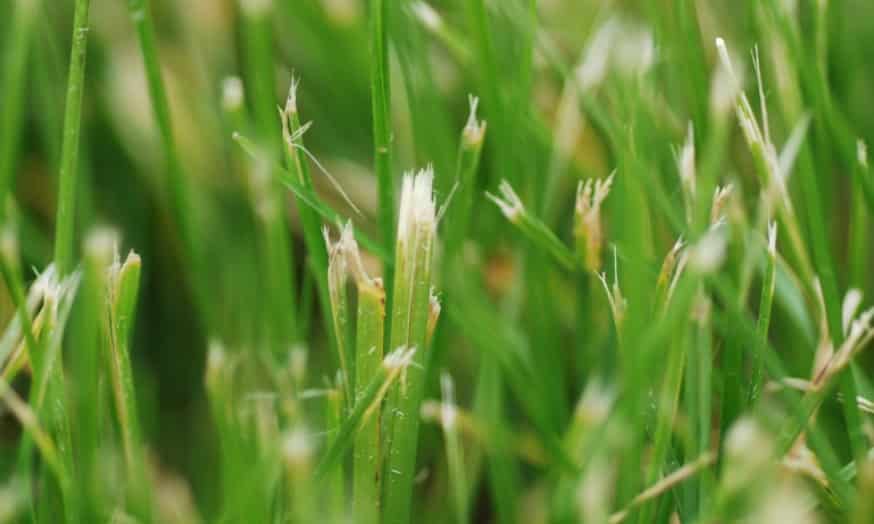

Above: A blunt mower blade will rip the grass plant’s leaves, rather than cleanly slicing them
Don't travel too quickly over the lawn
It’s important that the lawn mower doesn’t travel too quickly over the lawn as this can also cause the blade to rip the grass plant’s leaves. Some mowers are self-powered and will have a maximum speed at which they can travel. Pedestrian-powered lawn mowers however can be pushed quicker than they are designed to travel, which is where problems may start to occur. You should be mowing your lawn at a steady walking pace.
Pushing the lawn mower too fast is far worse than pushing it too slowly as the blade will not have a chance to cleanly slice each leaf off the grass plant. A fast pace will also reduce the amount of grass clipping that are picked up.
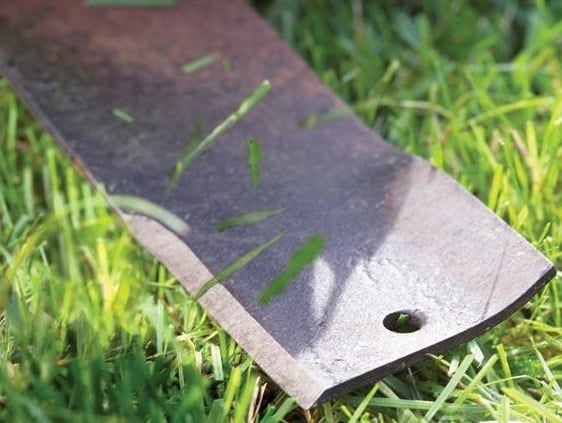

Above: The blades need to be able to cleanly slice each grass plant. Mowing too quickly can cause the blades to rip and damage the grass
Collect your grass clippings
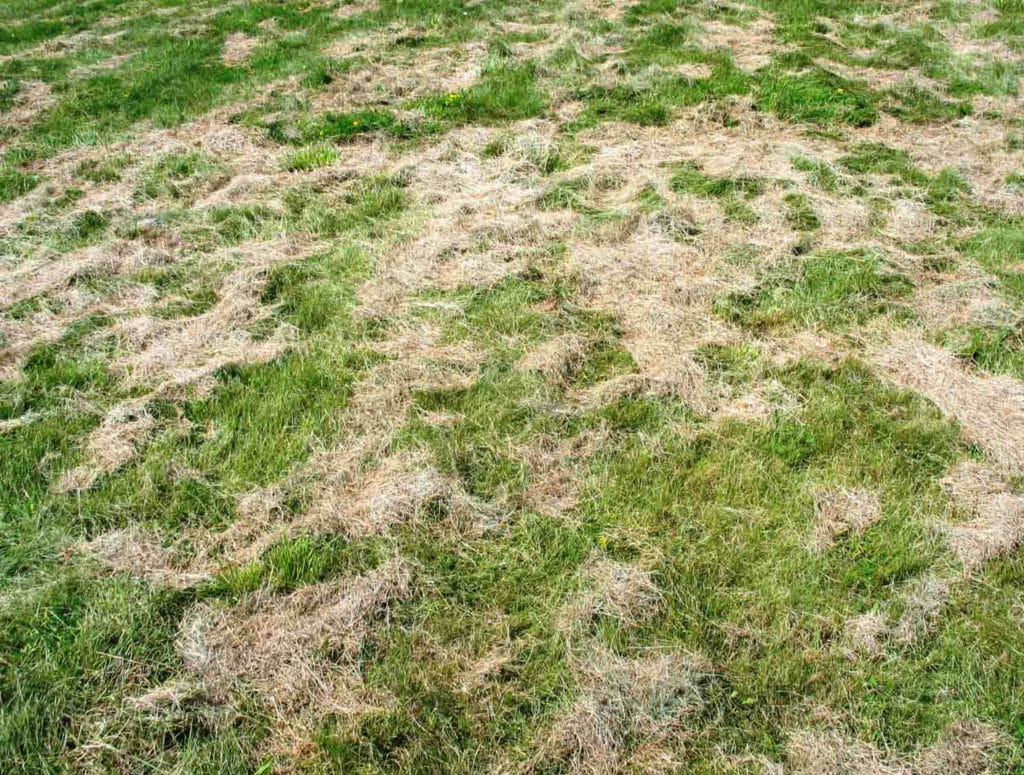

Above: Grass clippings left on a lawn will cause damage to the grass plants
Collecting grass clippings is important. Grass clippings lead to a build-up of thatch on the lawn.
Clippings that are left on the lawn will shade the grass, reducing the amount of light that reaches the lawn. If the cycle of leaving the clippings on the lawn is repeated, the constant shading of the grass plants will lead to yellowing or dead patches throughout the lawn.
Clippings that shade the grass plants can also increase the amount of fungal diseases.
Lawn mower types
There are two different types of lawn mower, each one defined by its cutting action:
- Cylinder mower
- Rotary mower
Cylinder mower
Cylinder mowers have front and rear rollers with a bedknife set at the desired cutting height, and a horizontal reel fitted with blades which push the grass onto the bedknife and cut it with a scissor action. The number of blades on the reel combined with the forward speed, dictate how fine the cutting quality will be. This is because the number of cuts per metre increases with the number of blades—from the lowest of four blades, giving 50 to 60 cuts per metre, up to the professional greens mowers with 12 blades, giving 500 or more cuts per metre.
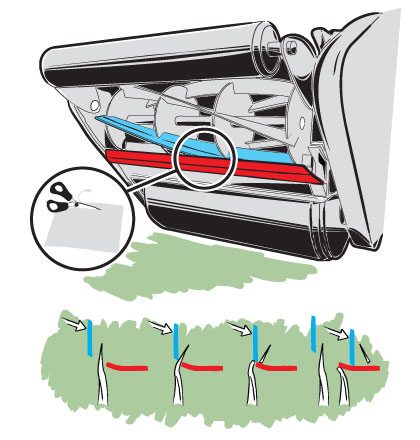

Above: The cutting action of a cylinder mower. The blade slices the grass blade using a scissor action
Realistically, cylinder mowers are the only option when it comes to better quality lawns and sports surfaces such as golf and bowling greens, as the cut is so much cleaner. This is not only because it looks so much better, but even more importantly, the grass plant recovers more quickly.
On the other hand, the blades on rotary mowers bruise and tear the leaf, giving a brownish appearance and causing it the leaf to heal much more slowly.
The other main advantage of cylinder mowers is their light rolling action, which makes the lawn surface firmer and smoother.
However, cylinder mowers are not very forgiving in comparison to rotary mowers. If a lawn is left too long without cutting, a cylinder mower will struggle. A cylinder mower demands a much stricter cutting regime.
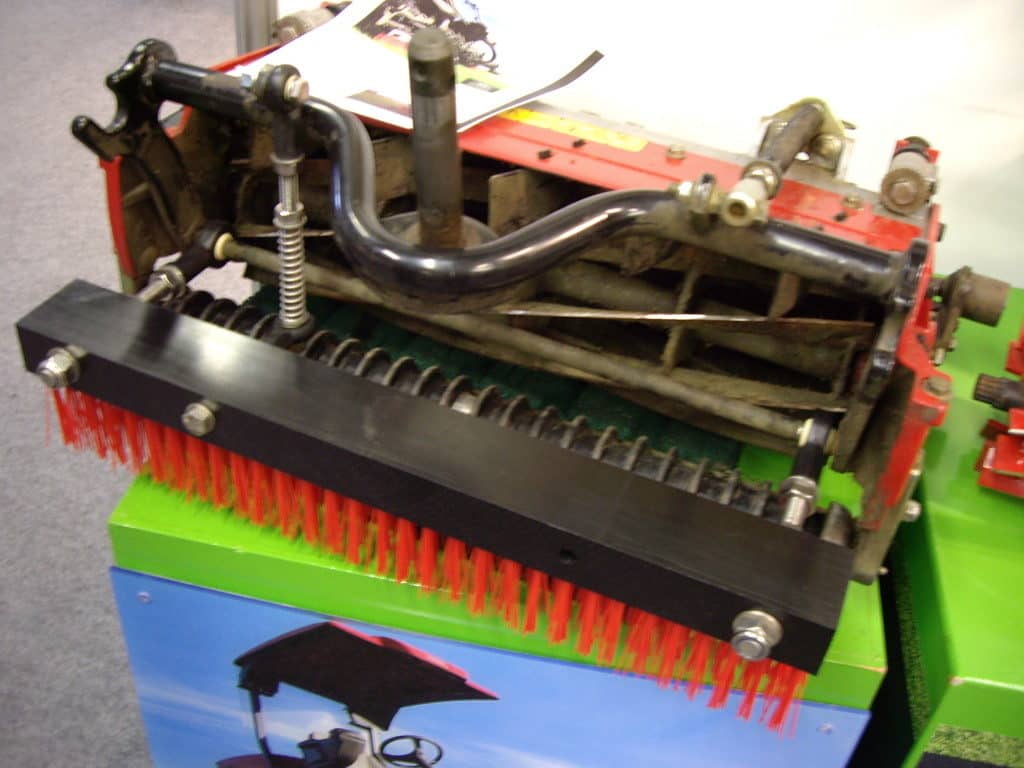

Above: A cylinder mower attachment
Cylinder mowers can be fitted with a variety of brushing and raking aids, either in front or behind the front roller, in this case a brush to lift the grass blades for cutting, and clear worm casts.
Cylinder mowers pick up and throw the grass into the collection box much more efficiently than rotaries, even in wet conditions. The ground has to be reasonably level, with no steep slopes, for any cylinder mower to work properly, and the lawn has to be cut regularly as these types of mowers do not cope very well with long grass.
A cylinder mower with four or five blades will offer a perfectly acceptable lawn mower for everyday use, with any increase in the number of blades giving a correspondingly better quality of finish. This has to be in conjunction with mowing more regularly as the blades being closer together means that they cannot cope with longer grass. This results in what is known ribbing—the blades try to chew their way through the sward. Longer grass also puts strain on the mower’s moving parts resulting in expensive repair bills.
Rotary mowers
Rotary mowers are by far the most common lawn mower found in our customers’ sheds. Rotary mowers work by spinning a blade at high velocity over the surface of the lawn. The blade is sharp at both ends and cuts the grass with a slicing action.
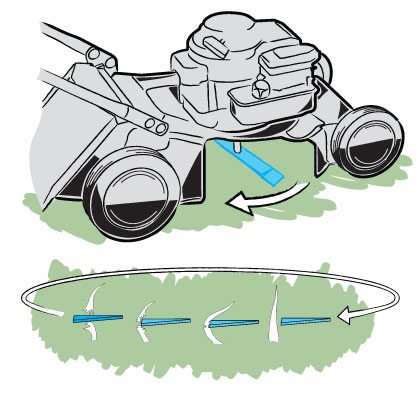

Above: The rotary mower blade slices the grass plant
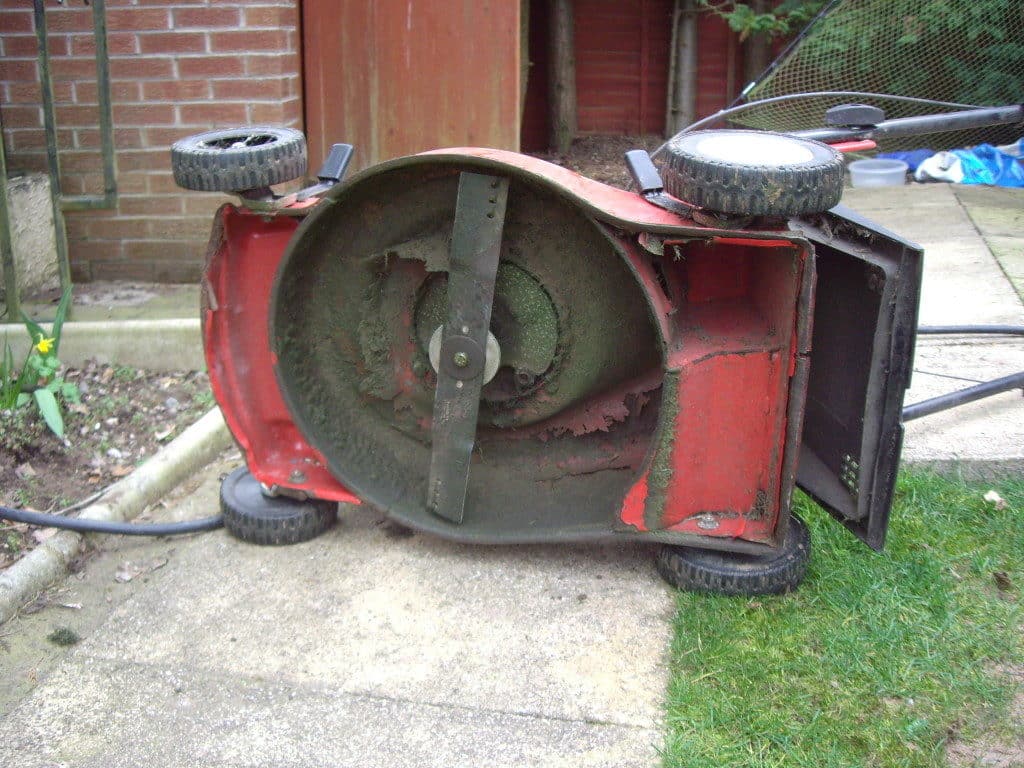

Above: The underneath of a rotary mower. This mower requires cleaning as there is a build-up of grass around the chassis
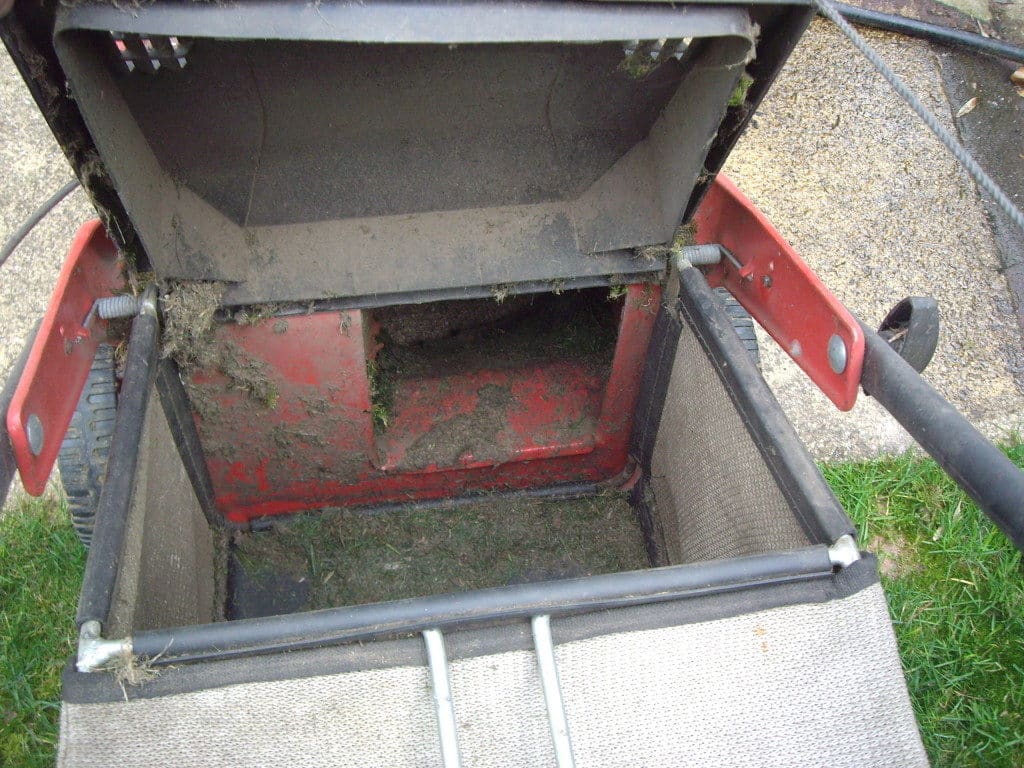

Above: The collector box of a rotary mower. The spinning blade creates a vacuum, sucking the grass clippings off the surface of the lawn. The spinning action then throws the grass into the collection box
What is a mulching lawn mower and should I use one?
Mulching lawn mowers are mowers that cut the grass clippings in to tiny fragments. Instead of collecting the grass clippings, they are deposited on to the surface of the lawn. Over time, these tiny grass clippings break down and release nutrients in to the soil.
In reality however, we have found that even small grass clippings can form a layer of thatch on the lawn. These mowers are not recommended, especially on domestic gardens where reduced airflow is a problem.
If you do use a mulching mower, it’s important to maintain a frequent lawn mowing regime to ensure you minimise the amount of clippings deposited at each cut.
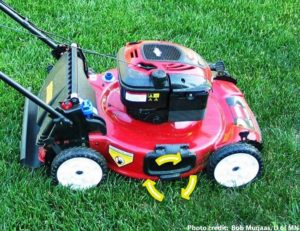

Above: Mulching mowers deposit the grass clippings back on to the surface of the lawn


Above: The clippings of a mulching mower are much smaller than the clippings of a regular rotary lawn mower
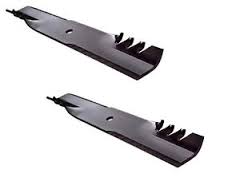

Above: The blades of a mulching mower have serrated upturned edge on the back of the cutting blade to help tear the clippings apart
Which lawn mower should I use?
This really depends on a combination of preference and practicality. Rotary mowers are much less forgiving than cylinder mowers. They can be used on wetter lawns and can cope with a higher grass growth. If you’re after quality, then a cylinder mower will be better, but it’s important to remember that you need to maintain a strict lawn mowing regime.
Should I use a strimmer?
Strimmers are not designed for cutting lawns. Strimmers work by spinning a plastic string at high velocity, which chops the grass plants or other green material it is targeting. Strimming is more commonly used on rough grounds where there is a requirement for a healthy looking lawn. We would highly advise our customers not to use a strimmer to mow their lawn.


Above: A strimmer being used on rough grass—strimmers must not be used on lawns!
What would happen if I didn't follow this lawn mowing advice?
As lawn mowing plays such a huge role in lawn care, doing it incorrectly could cause your lawn to look weak and sparse. If the lawn is left to grow too long, leading grass plants will start to shadow out surrounding plants, creating a sparse and often patchy lawn.
